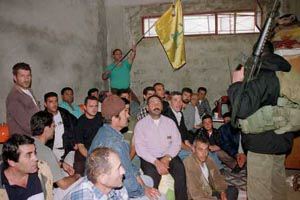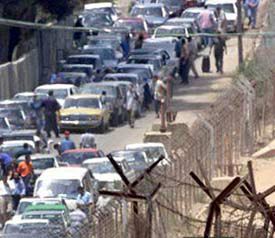Jointly published by the United States Committee for a Free Lebanon and the Middle East Forum
Back to June 2000 Table of Contents
Back to Middle East Intelligence Bulletin homepage.
Hezbollah Takes Control of South Lebanon
Israeli forces abruptly withdrew from south Lebanon earlier this month, over six weeks ahead of Israeli Prime Minister Ehud Barak's self-imposed deadline for ending the 22-year occupation. The operation, in which an estimated 1,000 Israeli soldiers pulled out of 12 fortified outposts, began on Monday, May 22 and was completed by dawn the next day.
According to Israeli military sources, the operation was originally intended to be only a partial withdrawal from outposts in the central sector of the security zone, inhabited primarily by Shi'ite Muslims. While the speedy collapse of Shi'ite SLA units was expected, IDF military planners had assumed that predominantly Druze and Christian units in the more heterogeneous eastern and western sectors would remain intact in hopes of benefiting from a UN-brokered deal with the Lebanese government.
 |
| A Hezbollah guerrilla guards former SLA militiamen in the village of al-Khiam on May 24. (AP Photo/Hussein Malla) |
However, SLA units throughout the security zone began to disintegrate almost immediately after Israeli troops began pulling out of the central sector and abandoned large stocks of heavy weapons and armored vehicles to advancing Hezbollah guerrillas, forcing the IAF to divert aircraft from ground support missions to the destruction of SLA arms caches. Even the SLA's 81st Regiment, which senior IDF officers described earlier this month as "a strong force that will never surrender" melted away without any sustained combat engagement.
The rapid collapse of the SLA appears to have been instigated by several factors. First, the threat made last month by Hezbollah Secretary-General Hassan Nasrallah to "liquidate" all SLA members who fail to surrender when the Israelis pull out1 was taken very seriously by the SLA rank and file. Second, SLA Commander Antoine Lahad supposedly abandoned his pledge to resist Hezbollah and flew to France immediately prior to Israeli redeployment, causing a tremendous drop in the morale of SLA fighters. Third, a secret deal reportedly negotiated in advance by Lebanese Druze leader Walid Jumblatt and Nasrallah resulted in most Druze SLA units surrendering en masse to Hezbollah--this left the remaining Christian units isolated and demoralized.
The collapse of the SLA supposedly led IDF commanders to request permission from Prime Minister Barak to abandon the seven remaining outposts in the security zone and leave south Lebanon altogether. Israeli officials have suggested that the collapse of the SLA was an unanticipated disappointment. According to Ha'aretz, IDF representatives openly joked about Lahad's conspicuous absence during the height of the chaos--"maybe there is some problem with his travel agency."2
However, Lahad and other senior SLA officials have given a very different version of events which has been confirmed by at least one IDF source. Lahad says that he traveled to France in mid-May for an extended visit with his family--the last opportunity to do so, he thought, before the situation in south Lebanon heated up prior to the scheduled withdrawal of Israeli forces by July 7. "I said in advance how long I would be away," said Lahad. "Every few hours I would get in touch [with the Israelis] and they said to me 'It's all under control everything is ok.' Until I took off from Paris I had no idea that the IDF had begun withdrawing." After belatedly learning of the disastrous turn of events in the south, Lahad quickly flew back to Tel Aviv and drove up to the border, only to discover that there was no South Lebanon Army left for him to lead.
Barak apparently decided some time ago to initiate a full withdrawal from Lebanon on May 22 and deliberately deceived Lahad and other senior SLA officers about this plan--even going so far as to schedule a state visit to the U.S. on that same day to be "canceled" as the last minute. There were two reasons for deceiving the SLA as to the date of the withdrawal. First, the Israelis were convinced that SLA commanders could not be trusted with this knowledge--the temptation for one of them to pass it on to Hezbollah in hopes of receiving lenient treatment afterwards would be too great. Second, Barak and other senior Israeli officials had been told repeatedly in meetings with UN officials that they would not sanction the Israeli withdrawal so long as the SLA was left intact. Lahad's talk of continued resistance after the withdrawal was a nightmare scenario for the Israelis. The IDF confiscated most of the SLA's heavy weaponry prior to the withdrawal (under the pretext that they served no defensive purpose and might fall into the hands of Hezbollah).
Lebanese President Emile Lahoud and other officials were said to have privately favored sending the Lebanese military to occupy positions abandoned by the Israelis. However, once it became apparent that the SLA was disintegrating completely, Damascus quickly interceded and ordered its client regime to hold back the military, arguing that the May 1991 Treaty of Fraternity, Coordination and Cooperation between the two countries prohibited the Lebanese army from serving the security of Israel. This allowed Hezbollah (and Amal) militiamen to sweep into the security zone and claim "victory" over the Israeli enemy.
The guerrillas entered village after village throughout the former security zone, erecting roadblocks, and conducting house-to-house searches for "Israeli collaborators." Gunmen typically stormed private residences, checked the identity papers of those inside and abducted anyone whose name matched their records of current and former members of the SLA. By the end of the week, 1545 residents had been arrested, or surrendered voluntarily, and were transferred into the custody of the Lebanese government. Most are expected to be sentenced to prison terms ranging from one month to several years.
In spite of Nasrallah's "liquidation" threat, there were relatively few reported murders by the guerrillas. On May 27, Girgis Hajj was shot to death and another resident wounded by a Hezbollah gunman in Rmeish. There have also been unconfirmed reports that at least four suspected SLA members were abducted by Hezbollah guerrillas and possibly executed. According to the Foundation for Human and Humanitarian Rights in Lebanon (FHHRL), which set up two monitoring stations in the former security zone, eyewitnesses reported the abduction of Nicholas Haddad and Atallah al Hasrouni by Hezbollah gunmen in Ayn Ibl on May 23. Both were reported dead two days later. Two other residents, Mer'i Khoury and Akl Mousa, were abducted and have not been accounted for.
Many houses were systematically looted of cash and valuables on the pretext that any significant accumulation of wealth by residents was a result of "collaboration" with the Israelis and therefore unlawfully obtained. There have also been reports that the homes of several "collaborators" were destroyed by Hezbollah demolition teams. Hezbollah guerrillas also seized hundreds of cars from residents of the former security zone who lacked registration documents. The fact that the area had been sealed off from the rest of the country for 22 years made lawful registration of vehicles through the Lebanese government very difficult and few residents had done so.
 |
| Lebanese refugees departing their homeland on May 23 |
Thousands of south Lebanese abandoned their homes and most of their possessions amid the relentless advance of Hezbollah guerrillas to seek refuge in Israel, forming a line of cars stretching back 2.5 miles from the border crossing near Metulla to the outskirts of Marjayoun. At one point, a Hezbollah gunman opened fire on the refugees, causing them to duck inside or behind cars for several minutes until Israeli soldiers managed to kill him (a spectacle captured live on Israeli television). By May 26, an estimated 6,000-8,000 refugees had crossed the border into the Jewish state. The refugees were sequestered in a restricted military zone, closed to the press, first at the Amnun holiday center on the northern shore of the Sea of Galilee and then in tents hastily erected in a nearby car park.
The Lebanese reaction to the Israeli occupation's dramatic finale has been mixed. Officials in Beirut have openly rejoiced, congratulating Damascus and Hezbollah for the South's "liberation" and encouraged citizens to tour the area, while doing little to guarantee their safety--so far seven people, including several children, have been killed or injured by land mines. Popular sentiment has been rather ambivalent, however. While most people are very happy to see the Israelis leave, Syria's refusal to permit the Lebanese military to deploy in the South is deeply resented by most Lebanese--it was the absence of Lebanese governmental authority in the South and the activities of anti-Israeli paramilitary groups which drew Israel into Lebanon in the first place. As long as Syria perpetuates these conditions, few expect peace and stability to return to south Lebanon. "There's no room for this hope until Lebanese sovereignty is freed from the heavy Syrian shackle," wrote Lebanese commentator Hazem Saghiyeh shortly after the Israeli pullout.3
1 AFP, 14 May 2000.
2 Ha'aretz, 24 May 2000.
3 Al-Hayat (London), 24 May 2000.
� 2000 Middle East Intelligence Bulletin. All rights reserved.
MEIB Main Page


